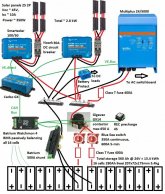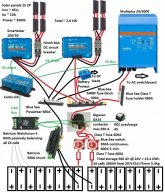Please see the diagram below - hopefully it's visible to everyone.
24V battery is dictated by existing DC loads, and 100V solar by local regs.

Two batteries in parallel, but either one could run alone. The Batrium BMS apparently can be told whether it's working with 13.4 kWh or half that amount, so it can properly monitor state-of-charge for the entire storage.
 support.batrium.com
support.batrium.com
 support.batrium.com
support.batrium.com
I'm aware that if one battery was disconnected and then reconnected later when they're at different states of charge, this could lead to a very high surge current between the batteries. Any ideas how to improve this?
For details on wiring the contactor pre-charge etc, I'm planning to copy Jan Gils' system - that diagram is more detailed in this area.

 diysolarforum.com
diysolarforum.com
24V battery is dictated by existing DC loads, and 100V solar by local regs.

Two batteries in parallel, but either one could run alone. The Batrium BMS apparently can be told whether it's working with 13.4 kWh or half that amount, so it can properly monitor state-of-charge for the entire storage.
Batrium
Batrium
I'm aware that if one battery was disconnected and then reconnected later when they're at different states of charge, this could lead to a very high surge current between the batteries. Any ideas how to improve this?
For details on wiring the contactor pre-charge etc, I'm planning to copy Jan Gils' system - that diagram is more detailed in this area.

Batrium BMS setup 8s3p
I'm building a new battery bank with 28 EVE 280Ah cells, and I'm wondering wether the following setup is valid. At 0.5C the battery pack can continuously handle about 400A, but in reality I will only use 200A (0.25C). Everything is designed on 400amps though. The system is 24V. The Batrium...
Last edited:



